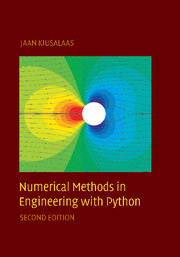Book contents
- Frontmatter
- Contents
- Preface to the First Edition
- Preface to the Second Edition
- 1 Introduction to Python
- 2 Systems of Linear Algebraic Equations
- 3 Interpolation and Curve Fitting
- 4 Roots of Equations
- 5 Numerical Differentiation
- 6 Numerical Integration
- 7 Initial Value Problems
- 8 Two-Point Boundary Value Problems
- 9 Symmetric Matrix Eigenvalue Problems
- 10 Introduction to Optimization
- List of Program Modules (by Chapter)
- Index
5 - Numerical Differentiation
Published online by Cambridge University Press: 05 June 2012
- Frontmatter
- Contents
- Preface to the First Edition
- Preface to the Second Edition
- 1 Introduction to Python
- 2 Systems of Linear Algebraic Equations
- 3 Interpolation and Curve Fitting
- 4 Roots of Equations
- 5 Numerical Differentiation
- 6 Numerical Integration
- 7 Initial Value Problems
- 8 Two-Point Boundary Value Problems
- 9 Symmetric Matrix Eigenvalue Problems
- 10 Introduction to Optimization
- List of Program Modules (by Chapter)
- Index
Summary
Introduction
Numerical differentiation deals with the following problem: We are given the function y = f(x) and wish to obtain one of its derivatives at the point x = xk. The term “given” means that we either have an algorithm for computing the function or possess a set of discrete data points (xi, yi), i = 0, 1, …, n. In either case, we have access to a finite number of (x, y) data pairs from which to compute the derivative. If you suspect by now that numerical differentiation is related to interpolation, you are right — one means of finding the derivative is to approximate the function locally by a polynomial and then differentiate it. An equally effective tool is the Taylor series expansion of f(x) about the point xk, which has the advantage of providing us with information about the error involved in the approximation.
Numerical differentiation is not a particularly accurate process. It suffers from a conflict between roundoff errors (due to limited machine precision) and errors inherent in interpolation. For this reason, a derivative of a function can never be computed with the same precision as the function itself.
- Type
- Chapter
- Information
- Numerical Methods in Engineering , pp. 177 - 192Publisher: Cambridge University PressPrint publication year: 2010
- 1
- Cited by



